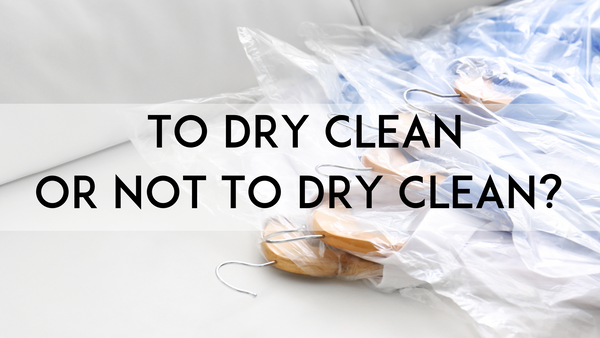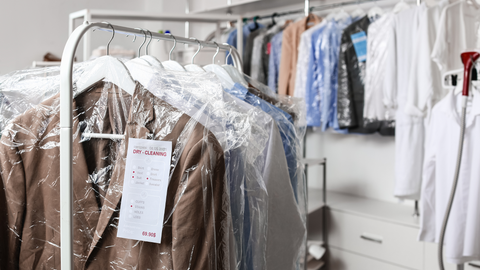
To Dry Clean or Not to Dry Clean?
We’ve all done it, looked at the tag and saw “dry clean only” or “hand wash only”, and still thrown it into the washing machine and just hoped for the best. Sometimes the odds are in our favor and other times we are almost in tears that we just ruined our favorite new purchase. So when does “dry clean only” and “hand wash only really mean exactly that? And when can you get away with bypassing the dry cleaners and just hand washing it yourself? Well, we are not the “experts” but here is what we do know.
Suggested fabrics to dry clean are rayon, linen, cool, silk, cashmere, velvet, leather and suede to name a few. You can easily check the fabric of your piece by checking the tag – this is also where you can find the care instructions.
Pass it off to the professional if it has:
Beading, sequins, or rhinestones
Oftentimes dry cleaners will have you sign a waiver when you send anything with beading details off to be cleaned. If the professionals can run into issues with beading, imagine what can happen if you decide to take matters into your own hands, or worse, just toss it in the washing machine. I think it is safe to say, you can say goodbye to that sweet little number.
Grommets, any kind of metal detailing
Metal detailing can be a chic and edgy accent to a number of pieces from coats to leggings. The key to keeping these embellishments looking shiny and new is by taking them to the dry cleaners. Otherwise you risk excess moisture getting caught in the pieces which can cause rust, tarnishing and eventually cause them to fall off.
Complicated Stains
Do you have an old or mystery stain that you’re not sure how to treat? It’s best to leave it in the hands of professionals. Not all materials or stains are made equal. While you may be able to treat it yourself, you don’t want to discolor or ruin the garment by using anything too abrasive, or even cause the stain to set deeper.
Fabrics that are new to you
You finally splurged and bought your very first silk blouse – it’s stunning and hangs off your body in just the right way. But if this is the first silk piece you’ve ever owned, take special care to learn how to clean it. If you don’t have a lot of experience with a certain type of fabric, it is best to follow the care instructions listed on the clothing tag. The last thing you want is to make it the first and last time you get to wear your new shirt.
Any delicate type of fabric
When you choose a delicate fabric like silk, chiffon, lace, or cashmere, you want it to have that same effortless elegance with every wear. Standard detergent can be too abrasive for a delicate fabric such as silk or cashmere causing them to shrink and bleed. Just like you after a long stressful week and work, delicate fabric needs a little extra tlc and pampering. Consider it like a spa day for your clothes!
Expensive or sentimental garments
It may be tempting to throw Great Grandma’s vintage dresses in with your weekly wash, but the chances that they could get destroyed just aren’t worth the risk. Anything you would cause you to be emotional if you were to never be able to wear it again, don’t risk it. Your favorite cashmere scarf from your summer trip to Italy? Don’t you even think about it!
Anything that is lined
Lining is a thin layer of fabric that sits on the inside of a garment, typically in dresses, coats, and skirts.The lining of your garment is usually a different material than the exterior fabric and may be more delicate. If you wash it in your machine at home, the lining could become detached, tear, or discolor because it cannot endure the same type of washing as the exterior layer.
Fabrics composed with rayon
Rayon is extremely prone to shrinking when it becomes wet or is exposed to any kind of heat, like hot water, or the dryer. The material actually weakens when it becomes wet, which can cause it to be more susceptible to damage. Rayon also wrinkles very easily. Save yourself the headache and just get it dry cleaned.
Items that are difficult to iron
One of the major positives of dry cleaning is that it comes back to you pressed and ready to wear. When you wash items at home with complicated pleats and folds, you’ll end up with wrinkles on wrinkles. Instead of sweating over an iron, and risking ruining the creases, take it to the dry cleaners and let them take care of it for you.
What exactly is dry cleaning

We all understand the dry cleaning process, you drop off your items, give them your name and phone number, they give you a slip with a number on it, you return in a few days and pick up your clothing adored on that expensive metal hanger and plastic bag.
If you are like us, you often wonder what exactly is dry cleaning… and why is it so darn expensive for us ladies? We can assume from the term, it is a waterless cleaning. Which is correct-ish.
Once your item is tagged, it is pretreated for stains and prepped for “washing” (this can include removing any embellishments, or covering/removing buttons). The garment is then placed into the dry cleaning machine and a liquid solvent is used. The clothing is then inspected, pressed, steamed, or ironed, any embellishments/buttons that were removed are then re-attached, the clothing is hung and bagged and ready for pickup.
What can happen if you don’t dry clean a dry clean only?
Chances are, you already have first-hand experience of what can happen if you don’t dry clean something that is dry clean only. If you’re lucky enough to have missed that particular rite of passage, we’ll fill you in…pilling, shrinkage, discoloration, color loss, damage… Oh my! If that’s still not enough to convince, here’s some specifics.
- Silk - shrinks and discolors
- Rayon - shrinks and discolors
- Wool - dramatic shrinking
- Linen - loses shape, additionally can be difficult to iron without scorching the fabric
- Suede & Leather - shrinks, cracks, stains, discolors
How to properly “hand wash”

It may seem like a timely chore, but handwashing is worth it to keep your favorite clothes looking like new. To find out if you need to handwash something, check the clothing label. This will also tell you if the fabric should be washed in warm or cool water.
Pre-treat any stains. Fill your sink, tub, or basin with water and a small amount of detergent. The size of the container you’re washing in depends on how many pieces you’re washing. Make sure to choose something large enough to fit everything.
Submerge the clothing and put those hands to work to gently wash your garments. Let the garments soak for up to 30 minutes. Drain the sitting water, refill water and rinse, repeat until the detergent is all out.
Once your clothing is free and clear from any remaining detergent, remove any excess water. Avoid wringing or twisting water out of the item as it can cause damage. Instead lay the clothing on a towel and roll the garment up into the towel, this will help remove any excess moisture from the item. Refer back to the laundry tag on whether the item should be laid flat to dry or hung up.
So, should you dry clean it?
It is always important to check the clothing tags, but ultimately the choice and the end result is all yours. But trust us when we tell you that the odds are better off in your favor if you follow the care instructions listed on the tags.
If you find yourself overwhelmed when looking at all those icons on that little tag, check out our Understanding Laundry Icons Blog.
